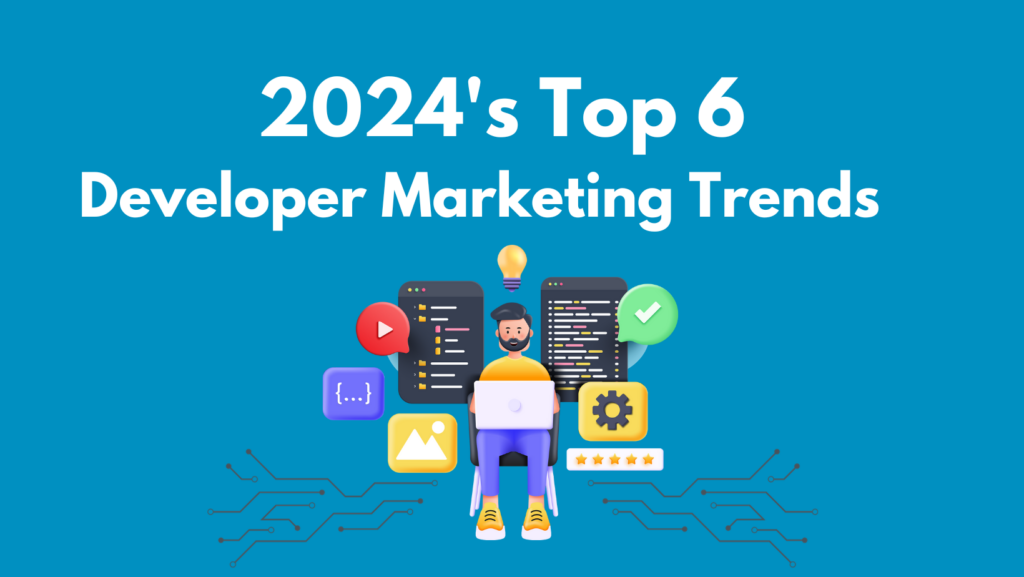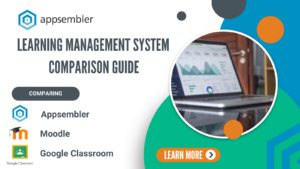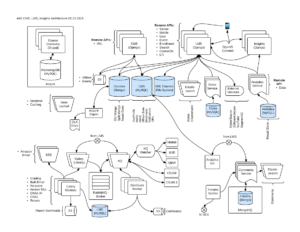In the dynamic world of developer marketing, staying ahead of the curve is paramount. This article will explore the top six trends defining developer marketing in 2024, providing businesses with invaluable insights to connect, engage, and thrive in the tech-savvy community. From content-centric strategies to the power of AI-driven personalization, these trends are set to reshape the landscape. Let’s dive in!
Key Takeaways
- Content is King: Developer-centric content will reign supreme, providing valuable insights and guidance.
- Community Building: Online developer communities are pivotal for engagement and collaboration.
- Advocate for Success: Developer advocacy programs are essential for building trust and loyalty.
- AI-Powered Personalization: AI tools will tailor experiences, enhancing engagement.
- Video Rules: Video content and live streaming will dominate, offering dynamic channels for interaction.
- DevX Platforms: Developer Experience (DevX) platforms are transforming the developer journey, providing streamlined onboarding and comprehensive resources.
Table of Contents
Trend 1: Content-First Approach
Unlocking the Power of Content Marketing
In the realm of developer marketing, content is the currency of engagement, the key to forging meaningful connections with the tech-savvy audience we seek to reach. Developers are discerning consumers of information, and to capture their attention, content must be not just informative, but extraordinary.
The Significance of Developer-Centric Content
Developer-centric content serves as the cornerstone of any successful developer marketing strategy. In 2024, businesses will increasingly recognize the importance of tailoring content to meet developers’ unique needs and interests. This shift towards developer-centricity is not just about pushing products; it’s about delivering value.
Consider a scenario where a developer stumbles upon your blog or video tutorial. They’re not looking for a sales pitch; they seek knowledge, solutions, and inspiration. The content-first approach means providing them with precisely that. Whether in-depth technical articles, hands-on coding tutorials, or insightful case studies, the content should be a wellspring of knowledge developers can trust.
Examples of Successful Content-First Strategies
To illustrate the power of a content-first approach, let’s look at some real-world examples:
1. Developer Blogs: Tech giants like Microsoft and Google have mastered the art of developer blogging. Their blogs are a treasure trove of technical insights, product updates, and how-to guides. These platforms serve as a trusted source of information for developers worldwide, fostering a sense of community and brand loyalty.
2. Interactive Documentation: Companies like Twilio have revolutionized developers’ interactions with their APIs. Through interactive documentation, developers can test API calls in real time, making the onboarding process seamless and engaging.
3. Video Tutorials: GitHub, the hub of all things code, has harnessed the power of video tutorials to simplify complex workflows. Their video content provides step-by-step guidance, making it easier for developers to navigate their platform and leverage its full potential.
By putting content at the forefront of their developer marketing strategies, these organizations have attracted developers and cultivated a sense of trust and reliability. In 2024, this trend toward developer-centric content will continue to grow, making it a cornerstone of successful developer marketing endeavors. The future belongs to those who can captivate, educate, and inspire developers through the content they create.
Trend 2: Community Buildiing
The Crucial Role of Developer Communities
Developer communities are the beating heart of the tech world. They are the bustling marketplaces where ideas, knowledge, and innovation are exchanged freely, and connections that can shape the future of technology are forged. In 2024, developer marketing will increasingly recognize communities’ pivotal role in nurturing relationships and driving engagement.
The Rise of Online Developer Communities
The digital age has witnessed a meteoric rise in online developer communities. These virtual hubs provide a space for developers to gather, collaborate, and share their experiences, making them a cornerstone of modern developer marketing. From open-source projects and forums to social media groups and specialized platforms, the options for engagement are diverse and boundless.
Benefits of Online Developer Communities:
- Knowledge Sharing: Developers crave knowledge, and online communities are treasure troves of insights, tutorials, and discussions. Whether troubleshooting a coding problem or staying updated with the latest industry trends, these communities offer a wealth of information.
- Networking Opportunities: Building relationships in the tech world is vital. Online developer communities offer a platform to connect with peers, mentors, and potential collaborators from around the globe.
- Feedback Loops: Engaging with the developer community can provide invaluable feedback on products and services. Developers are often quick to share their experiences and provide constructive criticism.
Showcase of Effective Community Building
Let’s take a look at some companies that have mastered the art of community building:
1. Stack Overflow: As one of the largest developer communities globally, Stack Overflow has become the go-to platform for developers seeking answers to their coding questions. By fostering a space where knowledge sharing is encouraged, Stack Overflow has become an essential resource for developers worldwide.
2. GitHub: Beyond being a code repository, GitHub has created a thriving community of developers. Features like pull requests, issues, and discussions have turned code repositories into collaboration hubs, enabling developers to work together seamlessly.
3. Red Hat: Red Hat’s OpenShift Commons is a prime example of community engagement. By bringing together users, partners, and contributors, they’ve cultivated a vibrant ecosystem around their open-source projects.
These case studies highlight the tremendous potential that lies in community building. In 2024, developer marketing will continue to emphasize the importance of nurturing and contributing to these online communities, recognizing that success in the tech industry is often built on the strength of the connections we forge.
Trend 3: Developer Advocacy Programs
Unleashing the Power of Developer Advocacy
Developer advocacy programs are the secret weapons of developer marketing. They are strategic initiatives designed to empower and amplify the voices of passionate developers about your products or services. In 2024, these programs will shine as beacons of trust, fostering deep connections between businesses and developers.
Building Brand Loyalty and Trust
At the core of developer advocacy programs is the idea of building authentic relationships. Developers are often the most critical and discerning users, and winning their trust is a significant achievement. Here’s how developer advocacy programs contribute to brand loyalty and trust:
- Credibility: When developers advocate for your product, it adds a layer of credibility that no amount of marketing can match. Their firsthand experiences and genuine enthusiasm are potent tools for persuasion.
- Feedback Loop: Developer advocates act as a direct feedback channel. They provide insights, suggestions, and bug reports, helping you improve your offerings. This iterative process demonstrates that you value their input and are committed to continuous improvement.
- Community Building: Developer advocates often operate within communities, both online and offline. Their engagement fosters a sense of belonging and shared values, making developers feel part of a larger, supportive ecosystem.
Companies Excelling in Developer Advocacy
Here are some companies that have embraced developer advocacy programs effectively:
1. Microsoft: Microsoft’s MVP (Most Valuable Professional) program is a shining example. It recognizes and rewards exceptional community leaders and influencers passionately advocating for Microsoft technologies.
2. IBM: IBM’s Developer Advocacy Program has a global presence, with advocates across various tech domains. They host hackathons, workshops, and webinars, fostering collaboration and innovation.
3. Twilio: Twilio champions developer advocacy by providing tools and resources for developers to excel with their communication APIs. Their advocates actively contribute to forums, write guides, and share their expertise, creating a vibrant developer community.
By investing in developer advocacy programs, these companies have not only gained the trust of developers but have also tapped into a powerful network of influencers who can drive adoption and brand loyalty. In 2024, as competition in the tech industry intensifies, developer marketing will increasingly recognize the pivotal role of advocates in bridging the gap between businesses and their most critical audience.
Trend 4: Personalization and AI
The Power of Personalization
In 2024, personalization will emerge as a beacon guiding developer marketing efforts. Like any other audience, developers crave tailored experiences that speak directly to their unique needs and interests. Personalization isn’t just about addressing developers by their first name; it’s about understanding their preferences, behaviors, and pain points to deliver content and solutions that genuinely resonate.
Enhancing Personalization with AI
AI-powered tools are the engines driving the personalization revolution in developer marketing. These tools harness the immense amount of data generated in the digital landscape to craft experiences that feel tailor-made for each developer. Here’s how AI takes personalization to the next level:
- Behavioral Analysis: AI can analyze a developer’s behavior on your platform or website, tracking what they search for, the content they engage with, and the products they explore. This data can be used to recommend relevant content or products.
- Predictive Analytics: AI can predict a developer’s needs and preferences based on historical data. For example, AI can suggest related resources or courses if a developer is interested in a particular programming language.
- Chatbots and Virtual Assistants: AI-driven chatbots and virtual assistants can provide instant, personalized support to developers. They can answer questions, troubleshoot issues, and guide developers based on their unique requirements.
Examples of AI-Driven Personalization
Several companies have already harnessed the power of AI-driven personalization in developer marketing:
1. Netflix: While not a developer-focused company, Netflix is a prime example of AI-driven personalization. Its recommendation engine analyzes your viewing history and preferences to suggest movies and TV shows you will likely enjoy. This concept can be adapted to suggest relevant documentation, tutorials, or tools for developers.
2. Amazon Web Services (AWS): AWS uses AI to personalize its documentation and resources for developers. When developers log in, they see recommendations based on their usage history, helping them discover relevant services and features.
3. Salesforce: Salesforce’s Einstein AI powers personalized customer experiences. For developers, this means personalized resources and support based on their past interactions with the platform.
In 2024, AI-driven personalization will become a standard practice in developer marketing. The ability to understand and cater to individual developer needs not only enhances user satisfaction but also boosts conversion rates and long-term loyalty. As AI continues to evolve, it will be essential for businesses to harness its capabilities to deliver exceptional personalized experiences to developers.
Trend 5: Video and Live Streaming
The Ascendance of Video Content
In the digital age, video has emerged as the undisputed champion of content consumption. Developers, who often thrive on visual and interactive learning experiences, are no exception to this trend. In 2024, video content will continue to reign supreme in the realm of developer marketing, offering a dynamic channel for engagement and education.
The Impact of Live Streaming
Live streaming is the rocket fuel propelling developer engagement to new heights. Live sessions create a real-time connection between developers and businesses, transcending the boundaries of traditional marketing. Here’s how live streaming is making an impact:
- Real-time Interaction: Live streaming allows developers to ask questions, seek clarifications, and engage in discussions with experts in real-time. This immediate interaction builds a sense of community and fosters trust.
- Demonstrations and Workshops: Live workshops and coding sessions provide developers with hands-on experiences. They can follow along, try out code snippets, and witness solutions.
- Product Launches and Updates: Live streaming is the perfect platform for unveiling new products, features, and updates. It creates excitement and anticipation, drawing developers into the conversation.
Tips for Creating Effective Developer-Focused Videos
Creating compelling developer-focused videos requires a thoughtful approach. Here are some tips to ensure your videos hit the mark:
1. Know Your Audience: Understand your developer audience’s specific interests and pain points. Tailor your video content to address their needs, whether it’s coding tutorials, debugging tips, or discussions on emerging technologies.
2. Keep it Interactive: Encourage engagement during live streams by actively responding to comments and questions. Foster a sense of community by acknowledging your viewers and their contributions.
3. Quality Matters: Invest in quality production. Ensure clear audio, crisp visuals, and a well-organized presentation. Developers appreciate content that is professional and easy to follow.
4. Be Authentic: Developers value authenticity. Be yourself, share your experiences, and admit when you don’t have all the answers. Authenticity builds trust.
5. Plan Ahead: For live streaming, meticulous planning is essential. Outline your agenda, prepare any code snippets or demos in advance, and have contingency plans for technical issues.
6. Promote and Archive: Promote your live streams in advance to build anticipation. Afterward, archive them on platforms like YouTube or your website so developers can revisit or discover them conveniently.
In 2024, video content and live streaming will continue to shape the developer marketing landscape. To succeed, businesses must harness the power of video to engage, educate, and inspire developers effectively. Remember, in the age of information overload, video offers a compelling way to stand out and capture the attention of this tech-savvy audience.
Trend 6: Developer Experience (DevX) Platforms
Revolutionizing Developer Experience
As we venture further into 2024, the spotlight shines brightly on a game-changing trend: Developer Experience (DevX) platforms. These platforms are designed to enhance developers’ journey, making it more seamless, efficient, and enjoyable. They are the bedrock upon which exceptional developer marketing efforts are built.
Improving the Developer Journey
DevX platforms are a holistic solution that provides developers with the tools and resources they need to excel. Here’s how they improve the developer journey:
- Streamlined Onboarding: DevX platforms simplify the onboarding process, offering clear documentation, tutorials, and interactive experiences to help developers get started quickly.
- Comprehensive Resources: These platforms offer a one-stop shop for developers, providing access to APIs, SDKs, libraries, and other essential resources. Developers can find everything they need in one place.
- Interactive Learning: DevX platforms often include interactive coding environments and sandboxes. Developers can experiment and test without fear of breaking anything, accelerating their learning curve.
- Community Engagement: Many DevX platforms foster community, allowing developers to connect with peers, ask questions, and share insights. This engagement builds loyalty and trust.
Notable DevX Platform Providers
In the DevX landscape, several providers stand out as pioneers and leaders, shaping how developers interact with technology. Notable names include IBM Developer, Microsoft DevOps, and Google Cloud’s Developer Tools.
Leveraging Appsembler for Developer Marketing
One standout player in the DevX platform arena is Appsembler. This leading provider specializes in creating immersive learning experiences for developers. Their platform empowers businesses to deliver top-notch developer education, drive adoption, and enhance brand loyalty.
Enhancing Developer Marketing with Appsembler
Appsembler’s solutions offer a unique blend of technology and education, making it an invaluable asset for businesses in the developer marketing space. Here’s how Appsembler can assist:
- Immersive Learning: Appsembler’s platform enables businesses to create interactive, hands-on learning experiences. Developers can gain practical skills and knowledge in a dynamic, engaging environment.
- Scalability: Whether you’re a startup or an enterprise, Appsembler’s solutions are scalable to meet your needs. You can reach a broader audience without compromising on quality.
- Analytics and Insights: Appsembler provides detailed analytics on how developers engage with your content. You can fine-tune your developer marketing strategies based on real data.
Conclusion
As we draw the curtains on our exploration of the six developer marketing trends for 2024, it’s clear that the tech industry is poised for an exciting journey ahead. Here’s a brief recap of the trends that will shape the landscape:
- Content-First Approach: In 2024, developer marketing will pivot towards creating high-quality, developer-centric content that educates and empowers.
- Community Building: Online developer communities will continue to thrive, offering fertile ground for engagement, collaboration, and knowledge sharing.
- Developer Advocacy Programs: These programs will become instrumental in building brand loyalty and trust by leveraging the voices of passionate developers.
- Personalization and AI: AI-powered personalization will enhance engagement by tailoring experiences to individual developer preferences.
- Video and Live Streaming: Video content and live streaming will dominate, providing dynamic channels for engagement, education, and connection.
- Developer Experience (DevX) Platforms: DevX platforms, exemplified by Appsembler, will revolutionize the developer journey, offering streamlined onboarding, comprehensive resources, and immersive learning experiences.
In a tech landscape that evolves at breakneck speed, staying updated with these trends is not just an advantage; it’s a necessity. Businesses that embrace these trends and adapt their developer marketing strategies will thrive in the ever-changing world of technology. Remember, developers are the architects of innovation, and by aligning with their needs and aspirations, your business can unlock new possibilities and reach greater heights in 2024 and beyond. The future of developer marketing is dynamic, and it’s yours to shape.
Frequently Asked Questions
Staying updated with developer marketing trends is paramount for tech companies for several compelling reasons:
Competitive Advantage: In the rapidly evolving tech landscape, staying ahead of the curve provides a competitive edge. Companies that embrace the latest trends can outshine competitors and attract a broader developer audience.
Relevance and Engagement: Developers are constantly seeking innovative solutions and approaches. Staying updated ensures that a tech company’s marketing efforts remain relevant and engaging, capturing the interest of developers.
Adaptation to Changing Needs: As developer preferences and behaviors change, so do their expectations. Being aware of trends allows tech companies to adapt their strategies to effectively meet developers’ evolving needs.
Efficient Resource Allocation: Staying informed about trends helps tech companies allocate their resources wisely. They can focus on strategies and channels that are most likely to yield positive results, maximizing their marketing ROI.
Innovation and Collaboration: By keeping abreast of trends, tech companies can identify opportunities for innovation and collaboration. They can partner with emerging platforms or leverage new technologies to enhance their developer marketing efforts.
AI-powered tools are revolutionizing personalization in developer marketing. Some of the AI tools commonly used for personalization include:
Recommendation Engines: AI-driven recommendation engines analyze user behavior and preferences to suggest relevant content, resources, or products to developers. These engines improve the user experience by tailoring recommendations to individual tastes.
Predictive Analytics: Predictive analytics leverage AI to forecast a developer’s needs and preferences based on historical data. This allows businesses to proactively provide content or solutions that align with developers’ interests.
Chatbots and Virtual Assistants: AI-driven chatbots and virtual assistants offer personalized developer interactions. They can answer questions, provide support, and guide developers based on their unique requirements, enhancing the user experience.
Segmentation and Targeting: AI can segment developer audiences based on various criteria, such as behavior, demographics, or interests. This segmentation enables businesses to target specific groups with personalized content and offers.
Natural Language Processing (NLP): NLP algorithms enable AI to understand and process human language. This is crucial for personalizing communication, such as email marketing or chat interactions, by tailoring responses to the developer’s context and preferences.
Content marketing is a potent tool for developer-focused businesses for several reasons. Firstly, it allows these businesses to establish themselves as thought leaders in their respective fields. By creating high-quality, developer-centric content, such as informative blog posts, in-depth technical articles, and tutorials, businesses can showcase their expertise and authority.
Secondly, content marketing helps in building trust and credibility among developers. When businesses consistently provide valuable and relevant content, developers are more likely to see them as reliable sources of information and solutions.
Thirdly, content marketing is an effective way to nurture relationships with developers throughout their journey. Whether educating them about new technology, addressing common challenges, or sharing best practices, content can guide developers and assist them at various stages.
Ultimately, content marketing drives brand awareness, fosters engagement, leads to conversions and contributes to the long-term success of developer-focused businesses.



